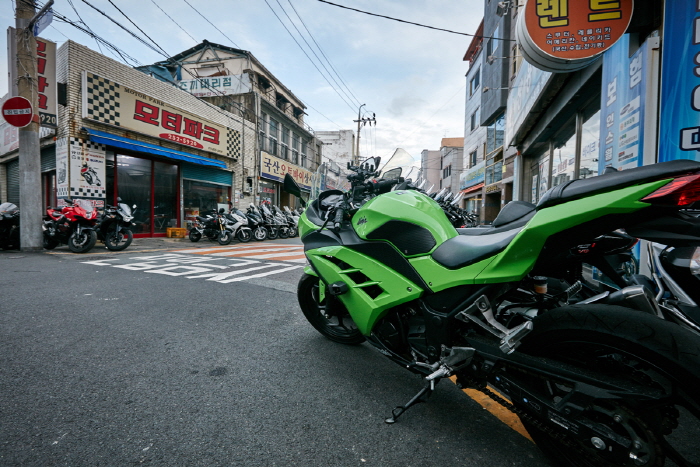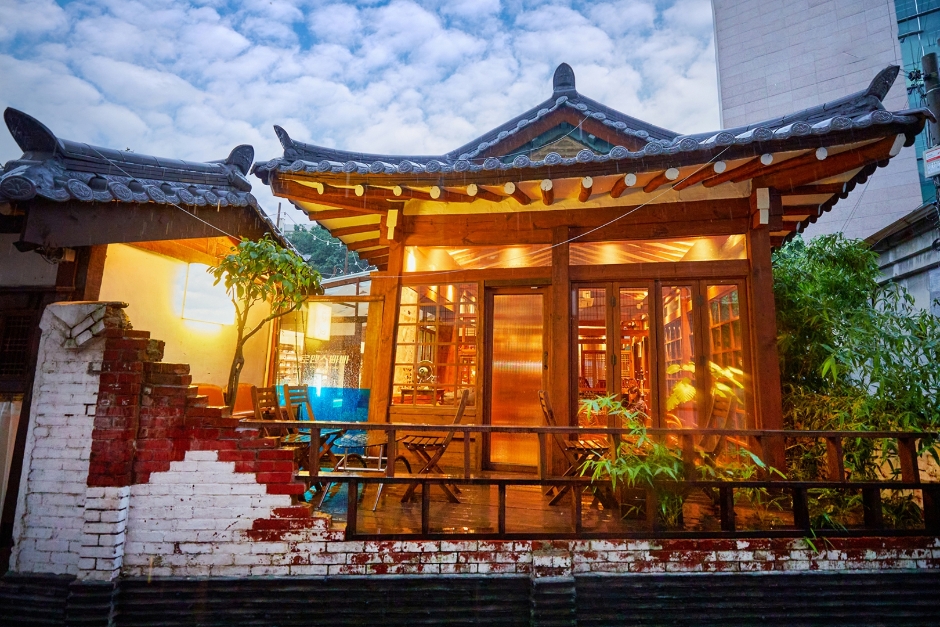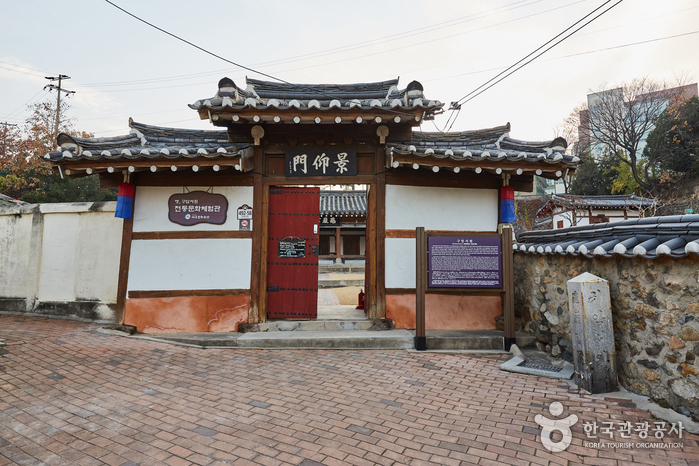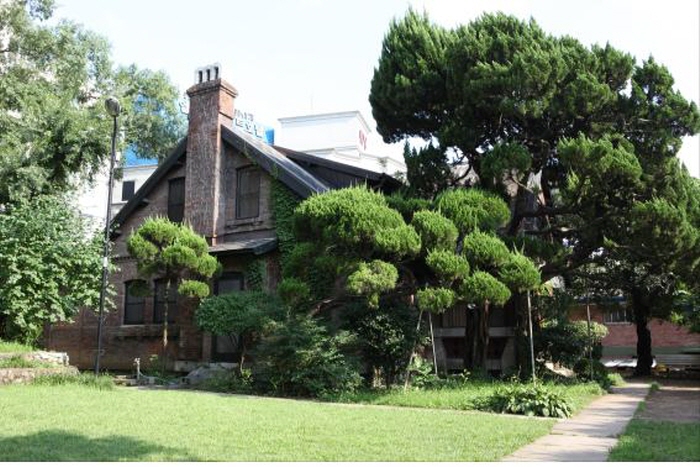Daegu Motorcycle Street (대구 오토바이골목)
0m 18656 2021-02-09
Ingyo-dong, Jung-gu, Daegu
+82-53-627-1337
Daegu Motorcycle Street is located in Ingyo-dong, Jung-gu, Daegu along Sijangbuk-ro. The street was originally a creek lined with houses, but in 1953 the creek was covered over and made into a paved road. Gas stations and stores selling automotive parts sprung up, turning the area into a thriving commercial district. In 1961, the first motorcycle store opened its doors and was quickly followed by several more.
Currently there are 40 motorcycle stores, making this 200-meter-long street one of Daegu’s most unique shopping areas. Shoppers can find a vast array of new and secondhand motorcycles both domestic and imported, as well as a wide selection of motorcycle parts and accessories.
Hanok 1957[Korea Quality] / 한옥1957[한국관광 품질인증]
102.84634521566339m 0 2023-09-05
20-2 , Gukchaebosang-ro 101-gil, Jung-gu, Daegu
+82-53-214-1957
Located downtown Daegu, Hanok 1957 is a traditional Korean hanok built with red pine and woven with clay and straw roof tiles. The rafters, beams, and cabinets inlaid with mother-of-pearl add comfort and tranquility to the interior. There are five guest rooms, all of which are ondol (underfloor heated) rooms with bathrooms. There is a shared kitchen where you can cook simple meals. Seomun Market Station and Daegu Station are within walking distance, and nearby attractions include Dalseong Park and Seomun Market are also nearby.
Romance Papa (로맨스빠빠)
238.14463619845287m 0 2024-04-01
492-6 Gukchaebosang-ro, Jung-gu, Daegu
This cafe is located near Seomun Market and Seomun Market Station on Daegu Subway Line 3. It is a hanok renovated with a retro and classic interior. Wooden doors and mother-of-pearl shelves between the seats create an atmosphere of warmth and relaxation, as if visiting a Korean grandmother's house. There are also seats in the yard where one can have coffee and dessert while enjoying the unique atmosphere of a hanok. The place has drinks and desserts made with various fruits and pour-over coffee. The signature menu here is called Perpetual Snow. It's similar to Einspänner, but it's topped with its own unique cream, so it's nutty and sweet. Visitors can also enjoy ade and smoothies with peach pulp in the summer.
Suchang Youth Mansion (수창청춘맨숀)
351.1901755641247m 0 2023-10-23
27, Dalseong-ro 22-gil, Jung-gu, Daegu
Once a derelict space and an eyesore, this facility was reborn as an art and cultural space. The building preserves its 50-year history with its old facade and houses an area dedicated to young artists in its interior, thus reborn as a space where the old coexist with the new. Suchang Youth Mansion, named so as a retro-style throwback to the old days when such English loanwords were not as common as today, opened its doors in December 2017. Today, it functions as a space for Daegu’s young artists. The first floor of Building A houses a cafe, while the second floor houses the art and cultural space, in which visitors can get a glimpse into Daegu’s unique identity through works of art, including those created by young artists of the region.
Daegu Art Factory (대구예술발전소)
363.3044862485489m 6365 2023-10-23
31-12, Dalseong-ro 22-gil, Jung-gu, Daegu
Daegu Art Factory is housed in an old tobacco plant, renovated into a space for art and culture. It hosts various exhibitions dedicated to Korean and international artists. Some of these include exhibitions dedicated to Daegu’s modernity, works of young artists, experimental projects, AI-based exhibitions, seminars, and art lectures. Through these exhibitions, Daegu Art Factory is cementing its status as an important platform for art exchange in Daegu. There’s also a space for families (children’s book reading room) for greater accessibility.
Old GuAm-seo-won
414.2733007150502m 16854 2021-04-09
492-58, Gukchaebosang-ro, Jung-gu, Daegu
+82-53-428-9980
Old Guam Seowon is a traditional Korean guesthouse located between Dongseong-ro and Seomun Market in Daegu. With land area of 2,300㎡, it has a total of six guestrooms, a shared living room, a bathroom, and a kitchen. The house has a large yard where guests can play various traditional Korean games such as "tuho" and "jaegichagi." In the backyard, guests can shoot arrows and try on traditional Korean clothes. Both the guestrooms and bathrooms were remodeled to have some of the modern conveniences. If you want, you can cook at the shared kitchen. Bread and cup noodles are served for breakfast. Situated in a residential area downtown, it's both quiet and very conveniently located for those planning to tour the city. Nearby popular tourist destinations include E-World, Daegu Nature Park & Spa Valley, Seomun Market, Gukchaebosang Memorial Park, and Kim Gwangseok-gil Street, with easy public transportation to and from the downtown area.
Seomun Market & Seomun Night Market (대구 서문시장 & 서문시장 야시장)
458.74999893036505m 66084 2023-11-17
45 Keunjang-ro 26-gil, Jung-gu, Daegu
+82-53-256-6341
Seomun Market opened in its current location in the 1920s after reclaiming the Cheonhwangdangji Reservoir, but it has a much longer history. In the Joseon dynasty, Seomun Market was one of three major markets in the nation. It was called Seomun Market because it was located on the west side of the Daegu Fortress. Despite relocating, the alleyways of the original market still feature names of the items available there, such as Hongdukkae Pancake and Chicken Pancake Alley. Textile-related goods are the main products available now, but they also offer a little bit of everything else, including silk goods, dry goods, undershirts, crafts, dishes, clothes, and dried seafood.
March 1st Independence Movement Road (3·1만세운동길)
551.3110842728762m 0 2023-01-20
Dongsan-dong, Jung-gu, Daegu
March 1st Independence Movement Road is a historical location where Daegu citizens gathered for the independence movement on March 8, 1919, and the midpoint of Daegu Modern Alley Tour Course 2. Passing Cheongna Hill Missionary's House and Jeil Church, you will come to a road with murals of the independence movement. The March 1st Independence Movement Road is a hilly road leading to Gyesan Cathedral. It is also called 90 Stairs because there are 90 steps. On the wall of the stairs, there is an augmented reality (AR) experience zone along with site photos from history. By scanning the QR code is a 3D video that vividly reproduces the independence movement, enabling a realistic experience of history. Follow the signs of the Daegu March 8th Independence Movement marching road to reach the main road and it will lead to the the 100th anniversary monument of the March 1st Movement and the starting point of the March 8 Movement. A guided alley tour is available for free with an online reservation on the official website.
Daegu Gyesan Catholic Church (대구 계산동성당)
592.2925868302777m 20655 2023-11-17
10 Seoseong-ro, Jung-gu, Daegu
+82-53-254-2300
Daegu Gyesan Catholic Church is one of Daegu's main churches, designed by Father Poisnel, who also designed Myeongdong Cathedral and imported stained glass for the windows directly from France. Being located in the city center, the cathedral is especially beautiful when seen at night.
House of Missionary Blair (선교사블레어주택)
635.0288553380516m 2312 2019-11-27
2029, Dalgubeol-daero, Jung-gu, Daegu
+82-53-661-2193
The House of Missionary Blair was built in in the 1910's for his time of missionary work in Korea, but has been converted into a history museum and education center. The two-story red brick building has maintained its original construction, with only minor changes having been made over the years. The house is very representative of its time, with a brick chimney rising over the roof, and wooden flooring inside. The first floor was made up of a veranda, reception room, living room, bedrooms, dining room and kitchen. The second floor featured bedrooms and a bathroom. The windows can be opened both at the top and the bottom, and the veranda was used as a sunroom. The House of Missionary Blair is a great example of American architecture from the 1900's.

![Hanok 1957[Korea Quality] / 한옥1957[한국관광 품질인증]](http://tong.visitkorea.or.kr/cms/resource/66/2998966_image2_1.jpg)




 English
English
 한국어
한국어 日本語
日本語 中文(简体)
中文(简体) Deutsch
Deutsch Français
Français Español
Español Русский
Русский